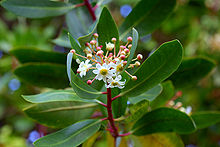Drimys winteri
| Drimys winteri | |
|---|---|

| |

| |
| Young adult | |
| Scientific classification | |
| Kingdom: | Plantae |
| Clade: | Tracheophytes |
| Clade: | Angiosperms |
| Clade: | Magnoliids |
| Order: | Canellales |
| Family: | Winteraceae |
| Genus: | Drimys |
| Species: | D. winteri
|
| Binomial name | |
| Drimys winteri G. Forst. | |

Drimys winteri, also known as Winter's bark, foye
Description
The leaves are lanceolate, glossy green above, whitish below and can measure up to 20 cm (8 in). The flowers are white with a yellow center, and consist of a great number of petals and stamens. The fruit is a bluish berry.
The
History
The canelo or foye is the sacred tree of the Mapuche, who associated it with "good, peace and justice",[7] often planted in special gatherings. Priests of their native religion were named foyeweye or boquibuye, "servant of the foye".[2]
When
Cultivation


Drimys winteri is grown in cool moist climates[11] as an ornamental plant for its red-brown bark, bright green fragrant leaves and its clusters of creamy white jasmine-scented flowers.
The species grows well in southern Great Britain, flourishing as far north as Anglesey. Specimens brought from the southern forests of Tierra del Fuego and planted in the Faroe Islands have proven to be especially hardy.[12]
This plant has gained the Royal Horticultural Society's Award of Garden Merit.[13][14]
It has been planted in the North Pacific Coast of the United States.[15]
The species is considered to have a potential for flood mitigation in northern Chile if planted in valleys.[4]
Other uses
Canelo wood is reddish in color and heavy, with a very beautiful grain. It is used for furniture and music instruments. The wood is not durable outdoors because continuous rainfalls damage it. The wood is not good for making bonfires because it gives off a spicy smoke.
The bark is gray, thick and soft and is used as a pepper replacement in Argentina and Chile. The peppery compound in canelo is polygodial.[16]
D. winteri is an
Notes
- . Retrieved 19 November 2021.
- ^ ISBN 956130970X.
- ^ "Angiosperms (Flowering Plants)". Earth.com. Retrieved 2023-10-19.
- ^ .
- ^ .
- ^ S2CID 31376453.
- ISBN 978-956-324-375-8.
- ^ Lynch, Robert G.; Spivak, Samuel (2017). Two Voyages to the Pacific Coast of North America: Francis Drake and Brune de Hezeta, Their Voyages Compared with Information about Scurvy. San Francisco: Drake Navigators Guild. p. 37.
- ISBN 9780743468701.
- ^ Alice M. Coats, Garden Shrubs and Their Histories (1964) 1992, s.v. "Drimys".
- ^ John L. Creech, providing American garden notes for Coats 1992, remarks of D. winteri and Tasmanian D. aromatica, both grown in British gardens, "These two species have not had much success here"; Drimys winteri is grown in the San Francisco Botanical Garden Archived 2012-03-09 at the Wayback Machine: (Capt. Winter is identified as "William Winter").
- ^ Højgaard, A., J. Jóhansen, and S. Ødum (eds) 1989. A century of tree planting in the Faroe Islands. Føroya Frodskaparfelag, Torshavn.
- ^ "Drimys winteri". Royal Horticultural Society. Retrieved 1 June 2020.
- ^ "AGM Plants - Ornamental" (PDF). Royal Horticultural Society. July 2017. p. 33. Retrieved 6 February 2018.
- ^ "Drimys winteri in Washington Park Arboretum" (PDF). Seattle Government. Archived from the original (PDF) on 2009-03-24. Retrieved 2009-06-27.
- ^ Muñoz-Concha, D., Vogel, H., Yunesc, R., Razmilic, I., Brescianic, L., and Malheiros, A., Presence of polygodial and drimenol in Drimys populations from Chile, Biochemical Systematics and Ecology, Volume 35, Issue 7, July 2007, Pages 434-438
- ^ a b
- Zapata, Nelson; Smagghe, Guy (2010). "Repellency and toxicity of essential oils from the leaves and bark of Laurelia sempervirens and Drimys winteri against Tribolium castaneum". S2CID 54820160.
- Zapata, Nelson; Smagghe, Guy (2010). "Repellency and toxicity of essential oils from the leaves and bark of Laurelia sempervirens and Drimys winteri against Tribolium castaneum".
References
- ISBN 956-7743-01-0.
External links
- History, botanical origin, description, etc. Hanburgy, Daniel and Friedrich August Flückiger (1879). Pharmacographia; a History of the Principal Drugs of Vegetable Origin... London: Macmillan and Co. pp 17–20.
- "Drimys winteri in Crarae Gardens, Scotland". Dendrological Plant Image Gallery. Retrieved 2009-06-27.
- . Encyclopædia Britannica (11th ed.). 1911.

